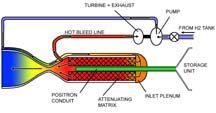Antimatter - as an energy source

Antimatter is the ultimate energy source. It releases energy with 100% efficiency (nuclear fission is 1.5% efficient.) Antimatter is 100,000 times more powerful than rocket fuel. A single gram contains the energy of a 20 kiloton atomic bomb--the size of the bomb dropped on Hiroshima. In addition to being highly explosive, antimatter is extremely unstable and ignites when it comes in contact with anything...even air. It can only be stored by suspending it in an electromagnetic field inside a vacuum canister. If the field fails and the antimatter falls, the result is a "perfect" matter/antimatter conversion, which physicists aptly call "annihilation." CERN is now regularly producing small quantities of antimatter in their research for future energy sources. Antimatter holds tremendous promise; it creates no pollution or radiation, and a single droplet could power New York City for a full day. With fossils fuels dwindling, the promise of harnessing antimatter could be an enormous leap for the future of this planet. Of course, mastering antimatter technology brings with it a chilling dilemma.Some antimatter reactions produce blasts of high energy gamma rays. Gamma rays are like X-rays on steroids. They penetrate matter and break apart molecules in cells, so they are not healthy to be around. High-energy gamma rays can also make the engines radioactive by fragmenting atoms of the engine material.
Antimatter is sometimes called the mirror image of normal matter because while it looks just like ordinary matter, some properties are reversed. For example, normal electrons, the familiar particles that carry electric current in everything from cell phones to plasma TVs, have a negative electric charge. Anti-electrons have a positive charge, so scientists dubbed them "positrons". When antimatter meets matter, both annihilate in a flash of energy. This complete conversion to energy is what makes antimatter so powerful. Even the nuclear reactions that power atomic bombs come in a distant second, with only about three percent of their mass converted to energy.
Previous antimatter-powered spaceship designs employed antiprotons, which produce high-energy gamma rays when they annihilate. The new design will use positrons, which make gamma rays with about 400 times less energy. If a rocket carrying a nuclear reactor explodes, it could release radioactive particles into the atmosphere. The positron spacecraft would release a flash of gamma-rays if it exploded, but the gamma rays would be gone in an instant. There would be no radioactive particles to drift on the wind. The flash would also be confined to a relatively small area. The danger zone would be about a kilometer (about a half-mile) around the spacecraft. An ordinary large chemically-powered rocket has a danger zone of about the same size, due to the big fireball that would result from its explosion. Another significant advantage is speed. The Reference Mission spacecraft would take astronauts to Mars in about 180 days. The advanced designs, like the gas core and the ablative engine concepts, could take astronauts to Mars in half that time, and perhaps even in as little as 45 days.On Earth, it has to be created in particle accelerators, immense machines that smash atoms together. The machines are normally used to discover how the universe works on a deep, fundamental level, but they can be harnessed as antimatter factories.
Image left: A diagram of a rocket powered by a positron reactor. Positrons are directed from the storage unit to the attenuating matrix, where they interact with the material and release heat. Liquid hydrogen (H2) circulates through the attenuating matrix and picks up the heat. The hydrogen then flows to the nozzle exit (bell-shaped area in yellow and blue), where it expands into space, producing thrust.
http://www.nasa.gov/centers/goddard/news/topstory/2006/antimatter_spaceship.html
0 Comments:
Post a Comment
<< Home